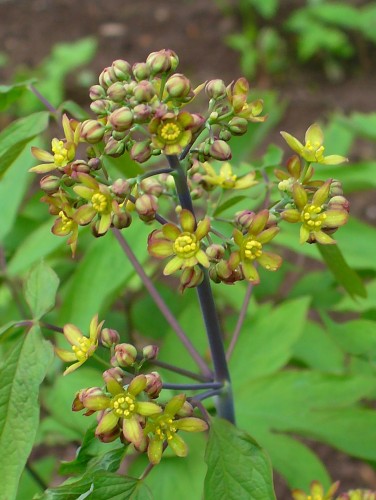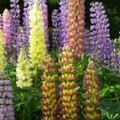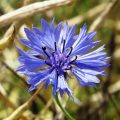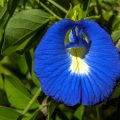- The Miraculous Shiny Bush Plant - January 18, 2021
- Colorful, Edible and Medicinal Celosia - January 10, 2021
- Radish, a Nutritional Power House - December 19, 2020
Blue cohosh, botanically known as caulophyllum thalictroides, is a perennial, flowering plant native to the woodlands of the US. The name cohosh is derived from the word co-os, meaning pine tree. This is probably in reference to the spiked appearance of cohosh plants. The second name, blue, alludes to the fruit borne by the plant, which is basically blue-green in color.
[Disclaimer: Large amounts of blue cohosh is known to cause headaches, nausea, and high blood pressure. In addition, The Right Flowers is not a medical site. Knowledge of and information about the therapeutic benefits and applications of flowers, while known through the ages, does not constitute medical advice. If you are having health issues, you should consult with a physician.]
The plant thrives in rich, moist soils with lots of shade. Curiously, blue cohosh is almost impossible to grow from seeds, but root divisions do well as long as they are planted in an environment similar to a woodland.
Blue cohosh produces tiny blossoms with 6 green to purplish sepals that are elliptical in shape resembling petals. However, the actual petals are normally at the base of the longer sepals. They are fan-shaped and produce nectar.
The flowers of blue cohosh are said to be parturifacient. This means that they have the ability to induce or facilitate childbirth. To facilitate labor, pregnant women would drink an infusion made from blue cohosh flowers which was made more potent by adding powdered roots of the plant. The concoction was normally taken a week or two before the due date and could not be drunk earlier because it carried the possibility of inducing premature labor, leading to a miscarriage.
Apart from inducing labor, blue cohosh is also famous for resolving gynecological problems including dysmenorrhea, amenorrhea, and menorrhagia.
Blue cohosh was so famous that it was included in the US Pharmacopoeia from the early 1800s to the early 1900s as an effective drug for inducing labor. During this period, midwives and physicians used it generously to induce labor. The plant was also widely used by Native American tribes such as Iroquois, Micmac, Cherokee and Penobscot as an analgesic and for resolving gynecological problems. Carl von Linne, a Swedish botanist, and physician recommended the plant for uterine problems, pain relief, and heart problems.
So, what makes blue cohosh an effective birth aid? Studies show that the plant contains a saponin known as caulosaponin. This is the compound responsible for stimulating uterine contractions to induce labor.
A series of laboratory experiments in 2012 suggested that blue cohosh extracts have the ability to inhibit the expression of certain pro-inflammatory cells. While the study was limited and inconclusive, the researcher concluded that the plant holds a lot of promise in treating inflammation. In addition, the plant is said to have anticonvulsant, antirheumatic, sedative and febrifuge properties.
Though science has not yet conclusively given blue cohosh the thumbs-up for use as a labor-inducing herb, the plant holds a lot of promise for facilitating childbirth.





